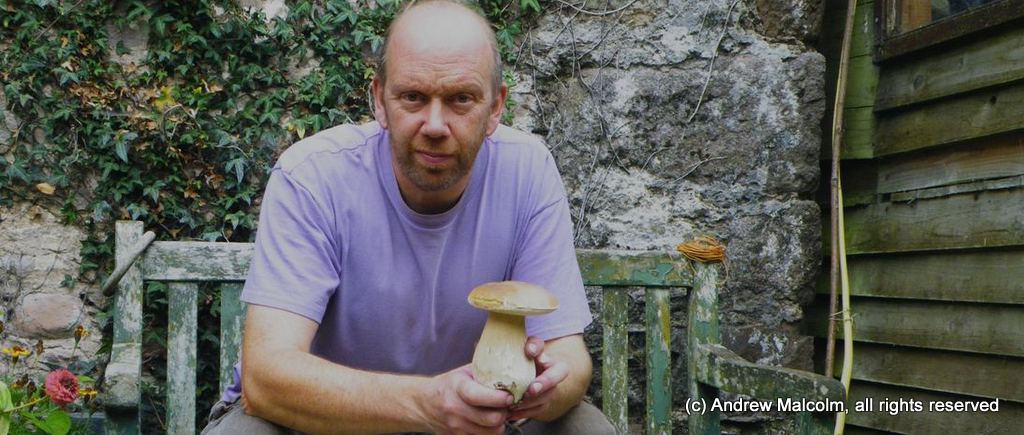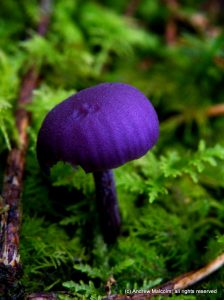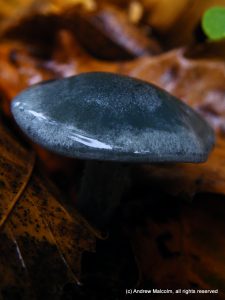It’s mushroom season — and foraging for fungi can be a great (not to mention tasty) way to while away an autumn morning — but as expert forager Andrew Malcolm explains, it’s not a pursuit that’s restricted to the autumn.
(NB. NEVER eat a fungus that you cannot positively identify 100% as being edible — if you are in any doubt leave well alone).

So what exactly is a mushroom? Well, it wasn’t until 1993 that fungi were placed into their own distinct kingdom and they are now regarded as being more closely related to animals than to plants. To date there have been somewhere between 70,000-80,000 species identified worldwide and almost 2,000 new species are discovered every year, so it’s clear that we still know very little about them.

The term macrofungus is used for species that have a visible structure that produces spores. This visible structure is what we commonly call a ‘mushroom’ or ‘toadstool’ and is in effect the fruit body of the fungus. The main portion of the fungus is often submerged in either the soil or below the bark of trees and consists of a mass of fine threads called hyphae, which together form a matted structure known as mycelium. This mycelium can cover vast areas and the largest organism on the planet is now believed to be a species of honey mushroom growing in Oregon’s Blue Mountains that is estimated to be 2,400 years old and occupies 2,384 acres.
My own obsession with mushrooms began innocently enough in the autumn of 1992 when my wife suggested we go out on a fungal foray. Like most Irish people I was pretty suspicious of wild mushrooms, expecting that the majority of things I would find would be deadly poisonous, but my insatiable curiosity got the better of me, so we headed out with a recently acquired guide book and collecting basket in hand. Within an hour of us setting out we came across our first mushrooms. By incredible good luck a picture of these large mushrooms featured on page one of the guide book, and by even greater good fortune it turned out we’d discovered a sizeable crop of ceps, one of the most sought after of all edible fungi-and thence an addiction was born. I was overwhelmed by the variety of mushrooms I found on that first excursion and so decided not to try and learn the identity of every species straight away (at that stage my ignorance was such that I believed such a feat was possible) but to slowly build up my knowledge with each passing season.
What I quickly realised was that although mushrooms were appearing in abundance in the forests surrounding my house in the autumn they were also around during the rest of the year. Some of these turned out to be edible as well. The ones that I first became familiar with I first found in February of 1993 and were growing off the broken or dying branches of the elder tree. These turned out to be the highly politically incorrectly named ‘Jews Ear’. Their appearance and texture were somewhat off-putting as far as edibility was concerned and I initially made the mistake of trying to fry them, not something I’d recommend as they exploded as soon as they hit the pan. Even trying to eat them after sautéing proved unsatisfying unless you like eating mushroom flavoured rubber bands! I eventually discovered that making stock with them was the best idea-but it proved to me that you can find edible mushrooms out of so called ‘season’. The other edible that can be found at all times of year here is the oyster mushroom, another species that grows on trees, this beautifully delicately flavoured mushroom appears here exclusively on Rowan trees but their appearance is completely unpredictable. Over the years I have found many trees in the same forest that produce oyster mushrooms but never have all the trees provided me with a meal at the same time. Most mushrooms fruit when climatic conditions are ideal for them to do so but oysters seem to appear for totally arbitrary reasons.
The first ‘proper’ mushroom of the year grows at my gate and appears with almost monotonous regularity on 23rd April, this is the aptly named St. George’s mushroom. This is one of those species that if it appeared at a different time of the year I would be hesitant to collect, as it has many lookalikes that are either inedible or even quite poisonous. This is one of the important things to remember when collecting edibles and avoiding confusion with dangerous lookalike mushrooms. Appearance, location and smell are other vital clues to help with identification. There is also a myriad of identification books available nowadays; the “bible” being Roger Philips’ Mushrooms but it wouldn’t necessarily be a tome that I would recommend to a complete novice as the comprehensive nature of the book can be a little daunting! Taken in association with the accompanying online guide www.rogersmushrooms.com it makes it an essential addition to the bookshelf of anyone wanting to take up mushroom hunting seriously, but as I mentioned earlier if you are just starting out it is better to start off slowly and use a guidebook dedicated solely to the edibles which also lists the dangerous lookalikes.

As I mentioned earlier the first mushrooms I ever found were ceps but it was many years before I came across that other “must have” of the edible mushroom hunter: the chanterelle. Finally I felt sure I’d found one, and this was one of those cases when smell became an important clue in identification, as chanterelles have a faint fragrance of apricots. Since then I’ve located many sites for these little golden nuggets that I will visit every year from late June when the first crop normally begins to appear. It’s rare that you’ll get a great crop of chanterelles every year and I’ve found over the years that a good year for ceps will mean it’s not a good year for chanterelle. Ceps also only appear in large numbers every few years, but when a combination of favourable conditions and this cycle of fruiting occurs there can be a glut. Ceps employ a symbiotic relationship with the roots of the trees they grow alongside, gaining carbohydrates whilst providing water and minerals to the tree. They also seem to have some kind of a relationship with the most distinctive of all mushrooms, the fly agaric. Many times I have found the two species growing in the same area of forest and this led me to some experimentation. The field behind my house has had fly agarics growing at the base of pine trees for many years, so when I found some ceps that had gone beyond their ‘best before date’ I placed them in the vicinity of the fly agarics. Several years later I was delighted to find a good crop of ceps had come up in the zone, though whether it was due to my experiment or just coincidence I’ll never know.
Mushrooms come in many weird and wonderful shapes, sizes and colours. One of my favourite for both colour and smell is the aptly named anise cap that has an almost overpowering smell of aniseed. Another favourite to find is the amethyst deceiver which although small can be found in large numbers and is quite tasty and, even better, is spectacular looking. The brightly coloured chicken of the woods is one of those mushrooms that is not only pretty but pretty unmistakable, being bright yellow and growing on old rotting hardwood trees. Unfortunately although many people can eat it and find it delicious, many others find it indigestible. It’s a good rule of thumb before you eat any wild mushroom, however confident you are of its identification that you eat only a little initially, because many people have an allergic reaction to various different species.
Although some mushrooms are indigestible others are deadly poisonous. Names such as Destroying Angel and Death Cap leave little to the imagination with regard to these mushrooms lack of edibility. The lethal qualities of these two mushrooms cannot be over emphasised as there is no known antidote to the toxins in them and there is a 90% chance of death from eating even a portion of one of them. Death Caps in particular are not uncommon and even if you pick one accidently and place it in your collecting basket with edible mushrooms it’s always better to discard the lot of them because the poison can transfer to the other specimens.
Once the main season for mushrooms has passed I’ll start looking for the most colourful of our mushrooms, the waxcaps, which grow on the local cricket pitch. Not all of them are edible but they are extraordinary in their variety of colours. I will also start searching for winter chanterelles. These small mushrooms grow in huge numbers some years, and are a wonderful addition to the larder throughout the winter months. A few years ago I was still collecting them as late as February when I was in fact snapping them off as they were still frozen solid-as were my fingers.









11 comments
Berny
Do you know if Maitake grow in Ireland please?
Darren daly
Hi andrew was reading your article are ceps a bit scarce this year
Daniel Shields
Thank you for sharing your adventures in hunting mushrooms. Hope that I can do the same and just enjoy nature too.
I can not stop to be in awe always with nature on how magical it is.
Liam McMullin
Hi,
I think I have a patch of Agaricus bitorquis. The biggest of these is 26cm across the cap. The cap is pale white with regular light brown spots arranged in a circular fashion. The gills are brown going dark brown on the older mushrooms, the spores are black. It has a typically pleasant ‘mushroomy’ scent. The stem (I haven’t cut it yet) is at least 2.5 cm in diameter. Am I right? I have photos.
Martin
Hi Andrew, what mushrooms are in season now particularly. Having went on a great foraging trip in Killarney recently I’m eager to go searching. Not being overly familiar I normally just take photos and then ask people in the know what they are.
Regards,
Martin
Lisa
Hi Martin,
I know your comment is YEARS old but I’ve been trying to find a group to go mushroom hunting with. I live in Kerry and am a complete novice. Was it a Killarney group you went foraging with?
Andrew Malcolm
Hi Nikki-they’ve been around since early June this year and I’m still finding them now, I guess you just haven’t looked in the right place yet!
best of luck
Andrew
aangelickaNikki
Hi Andrew,
Do you know when is the best time to find Cantharellus ? I am very familiar with this mushroom but have never actually seen it growing in Ireland.
best regards,
Nikki
Jim
Gibberish (the comment not article)
brixy
Rohdina must b on d liberty caps ha.d funny ting is I actually understood ye
rodica
hi.im rodica from Dublin if is possible to know in the forest of fungus found in
the image.fungus that in your hand in which part of Ireland.thankyou